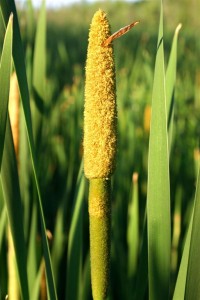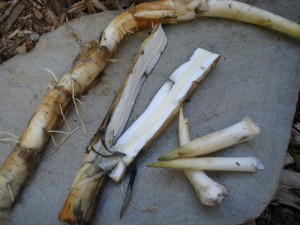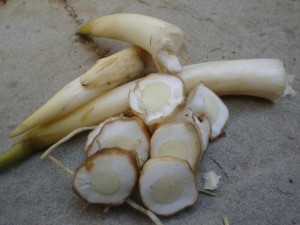One of the most useful and plentiful plants for foraging or survival situations are cattails. As a food plant, cattails are an outstanding emergency food source and offer a variety of food products according to the season. Nothing produces more starch per acre under cultivation than cattails, even outperforming potatoes, with more than 6,000 pounds yield.
In early spring, dig up the roots to locate the small pointed shoots called corms. These can be removed, peeled, and eaten, added to other spring greens for a salad, or cooked in stews or alone as a pot herb. While we did not eat many cattail products growing up, this was on delicacy that my father introduced me to. As the plant growth progresses to where the shoots reach a height of two to three feet above the water, peel and eat like the corms, or sauté. Due to Russian fondness for this early phase of growth this food product has been referred to as “Cossack Asparagus”.
In late spring to early summer, some of the best food products come into fruition on the cattail. Shortly after the Cossack Asparagus becomes available the green male pollen and female bloom spikes begin to emerge. The spikes are located in the center of the plant, forming a cylindrical projection that is only detectable when one is close to the plant. Just like shucking corn, pull back the leaves to reveal the male potion above and the female portion below. The female portion is what will later become the familiar brown cattail, while the mail portion above shrivels to a dried twig. Both the male and female pollen spikes can be boiled and eaten like corn on the cob or eaten raw. The male portion provides a larger meal than the female portion. The flavor has been described as similar to corn, but distinct and very palatable.
Later, the male pollen head will develop a yellow talcum like powder that can easily be shaken off into a container; there is a large output and it takes little time to collect. Run the pollen through a sieve for cleaning. The pollen is typically used to substitute some of the flower in foods like bread, some cakes, cornbread, and pancakes.
In late summer to early fall, Due to the toughening up of the plant Cossack Asparagus dwindles, but the tender inner portions of the leaf stalk may still be collected. During this time period the most abundant food product may be harvest, the root starch. It is so abundant; a study was conducted at the Cattail Research Center of Syracuse University’s Department of Plant Sciences. The chief investigator of the project was Leland Marsh. The reported results were as follows:
Yields are fantastic. Marsh discovered he could harvest 140 tons of rhizomes per acre near Wolcott, NY. That represents something more than 10 times the average yield per acre of potatoes. In terms of dry weight of cattail flour, the 140 tons of roots would yield approximately 32 tons.
To extract flour and start collect the cattail roots then wash and peel them. Break up the roots underwater and the flour will begin to separate from the fibers; continue till all the flour is removed from the fibers. Remove the fiber and poor off the water. Slurry and dry by exposure to low temperatures or the sun. This starch has a consistency and taste similar to mashed potatoes and can be eaten as is or added to other foods. The fibers are typically too tough to eat with the exception of new shoots, although I have seen examples of slicing the roots and frying them like potatoes. These new shoots can be cooked or eaten raw.
“Cattail root flour also contains gluten. Gluten is the constituent in wheat flour that allows flour to rise in yeast breads. The Iroquois Indians macerated and boiled the roots to produce syrup, which they used in a corn meal pudding and to sweeten other dishes. Some Indians burned the mature brown seed heads to extract the small seeds from the fluff, which was used to make gruels and added to soups.”
Referencing the cliché cattail, Dan, a good friend of mine, let me know that when he goes hunting in the autumn he uses the cattail fluff as a fire starter; and has heard of people in emergency situations using the natural down as an insulator in clothing.
The incredible cattail: The super Wal-Mart of the swamp, Kevin F. Duffy, Back woods home magazine Issue #43 • January/February, 1997
Survival wisdom and know-how compiled by Amy Ross, 2007
survivalistboards.com





Hi,
I have a website about connecting kids with nature. It’s all about inspiring kids to go outdoors and explore the magic in our natural world. http://www.gallavants.com
One of the options on the site is Plant of the Month. The one coming up next is actually Cattails.
We have a e-book coming up about this plant as well.
We did a lot of research before writing the book and I really appreciate your take on it as well.
I do have a question / request; I need a good photograph of the male / female flower and find yours to be one of the best I’ve seen, could I use it on my website? What would you charge?
Please let me know what works for you. Thanks